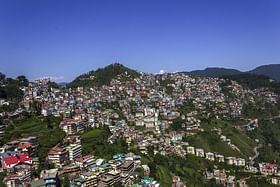The Himachal Pradesh Housing and Urban Development Authority (HIMUDA) has received approval to acquire land for the development of a new township known as ‘Mountain City.’
According to the PTI report, this township will be located in the vicinity of Jubbar-Hatti Airport, on the outskirts of Shimla.
The primary goal of this endeavour is to alleviate congestion in the state capital while fostering economic growth and employment opportunities.
‘Mountain City’ project is set to revolutionise Shimla, promising to deliver a cutting-edge, ultra-modern city with state-of-the-art infrastructure and advanced seismic technology.
As per an official statement, the estimated cost of this ambitious venture is approximately Rs 1,373 crore.
In an effort to assist individuals across the state who have been grappling with payment disputes, the Board of Directors has greenlit a one-time settlement (OTS) policy.
This policy offers a chance for individuals to resolve longstanding payment issues at a significantly reduced rate. This move not only eases the financial burden on the public but also consolidates resources for HIMUDA’s reinvestment into community-benefiting projects.
During the 52nd meeting of the Board of Directors (BoD) of HIMUDA, Chief Minister Sukhvinder Singh Sukhu issued directives to make provisions for the regularization of attic spaces in buildings under the One-Time Settlement Policy. Furthermore, the policy will be updated to align with decisions made by the state government regarding attics in buildings.
The Chief Minister has stressed the importance of embracing the latest construction methods and utilizing information technology platforms to enhance HIMUDA’s presence and service delivery to the public.
The adoption of electronic measurement books (e-MBs) has been recommended to streamline record-keeping and reduce reliance on physical documentation.
Additionally, the implementation of the e-tendering system, following the latest government guidelines, has been encouraged to expedite the tendering process, reports Financial Express.
Promoting innovation and capacity development, Sukhu has urged HIMUDA to operate competitively, embark on innovative initiatives in its projects, enhance the size and user-friendliness of flats, and organise exposure visits for employees to facilitate capacity building.
Need For Sustainable Urban Development In Shimla
Shimla, prior to its development as a hill station was described as an “obscure village”. The village was named ‘Shimla’ after the temple of Goddess Shyamala located in the village.
Known as the ‘Queen of Hill Stations’, Shimla has become a multifunctional city along with the dominance of tourism, administrative and institutional activities.
As a result of the increased urbanisation in and around hill cities, Shimla is currently experiencing issues with traffic, water scarcity, landslides, pollution of lakes and streams, damage to scenic attractiveness, and visual blight.
Ecological Concerns
For the past few decades, the importance of Shimla’s historical development, in terms of meticulous planning in accordance with environmental and ecological imperatives, and harmony of natural and built heritage has lost its sheen.
The city has witnessed the unprecedented impact of urban ills, especially haphazard construction activity and congestion of its prime tourist locations.
Shimla is also witnessing a spurt in construction activities, during the last few decades.
As per experts, about 90 per cent of the core city area has been built on slopes more than 60 degrees, thus making these constructions against architectural and geological norms. These factors make Shimla highly susceptible to natural disasters.
The area is also located in severe earthquake zones IV and V.
Seasonal landslides and uprooting of trees sometimes lead to deaths, extensive loss of property, and loss of livelihood ruining roads and infrastructure.
Population Pressure
The unplanned and indiscriminate development in the core, non-core, green and rural areas in Shimla Planning Area has given rise to serious environmental and ecological concerns.
Shimla was originally planned for a population of 25,000 people, while it accommodates more than 2,40,000 people besides the floating population of tourists.
In the past 120 years, the population has increased more than 15 times.
Urban Sprawl
The city is spread over seven hill spurs, namely, Jakhoo Hill, Elysium Hill, Museum Hill, Prospect Hill, Observatory Hill, Summer Hill, and Potters Hill. These spurs are interconnected by roads.
Thus, the development pattern in Shimla is governed by topographical constraints such as steep slopes, elongated hilly spurs, forest areas and zones of perpetual sunshades.
Shimla is growing beyond its seams by leaps and bounds. Ribbon development along the highways and even along the minor roads emanating from the city is a common feature. A vast cityscape is in the formation.
Whereas the already existing areas have become congested, the fringes and peri-urban areas, especially the prominent ridges like Sanjauli, Cemetery, Dhalli, Bhattakufar, Mehli, Kangnadhar, Khalini, Bharari etc. are acquiring considerable proportions of development.
Irregular Building Plans In Shimla
Many buildings in Shimla have an irregular plan, that is, L shape, U shape etc. Buildings with regular plan (rectangular or square) perform better during earthquakes.
If irregular shapes like L, H, U or + are designed, construction joints should be provided at the junction of two different wings to avoid re-entrant corners. If a construction joint is not provided, buildings have the tendency to separate out from these corners.
The dimension of the offset and the proportion of the derived wings will determine the vulnerability of a building.
Rise In Slum pockets In Shimla
There are 53 slum pockets identified in the Shimla Municipal Corporation area (source: SMC), in which, there are 1,972 households/structures housing a population of 11,874, which is around 4 per cent of the total population in the city.
Unsustainable Tourism In Shimla
Present trends in tourism in Shimla are oriented towards increasing tourist volume. As a result, it threatens the capacity of tourist attractions because of overcrowding, congestion, traffic snarls and environmental pollution.
Aggressive tourism activities without proper planning, effective policy and institutional framework have created serious environmental problems in the mountain city.


